#there's a feeling of spectatorship to it
Explore tagged Tumblr posts
Text
There's something so sickening about how the only hope of survival for many victims of the genocide in Palestine is the parasocial relationships they can form online. It's something straight out of the Hunger Games.
#it's good to have awareness to keep our eyes on palestine and witness and know what is happening#it's the least that we could do to know ppl as something other than an endless string of numbers#but the way people are responding on social media to specific individuals and quoting their most heartbreaking quotes or whatever#there's a feeling of spectatorship to it#maybe it's just me#but i think it's been happening for a long time and no-one's acknowledging how close we are to making atrocities entertainment#it began with the vietnam war when it was televised and people named massacres 'the most dramatic episodes'#and i think it's still happening now#free palestine#rambles#it's dehumanising how we can just scroll and look at children's corpses one video and then a meme in the next post#it's the absolute desensitizing of actual human suffering
3 notes
·
View notes
Text

Attending the Yankees Game | New York City, NY | October 15, 2024
The Row 'Clotho Oversized Blazer' - $3,350.00 Louis Vuitton 'Micro Damier Insert T-Shirt' - $1,060.00 Louis Vuitton 'Side Trunk Bag' - $3,950.00
Even from far away, I know that this is an outfit I would personally copy + paste in a heartbeat. The combination of rich neutrals and oversized blazer truly have my heart. Plus the casual baseball cap (I, too, am entering my cap accessorizing era).
I love the combo of the black + brown of this top featuring the iconic LV Damier motif in a sporty silhouette that feels appropriate for Taylor’s expansion into the world of sports spectatorship. It’s the perfect laidback ‘fit for a ball game that’s inconspicuous but polished.
Photo by Patrick Smith via Getty Images
129 notes
·
View notes
Note
okay but i absolutely adore your writing and i hope you are having a wonderful day!
if it’s okay to request bodyguard!sirius with shy!reader where sirius loves to be all flirty and tease the reader in their private moments to get her to smile as he knows how tense and stressful her life is and just wants to give her a moment of peace💌
thank you for your request, sorry it took so long! bodyguard!sirius x shy!reader
Sirius, when looking at himself, doesn’t necessarily think that he looks the part of a bodyguard. He has muscle — his arms look bulky enough to signify that he spends a moderate amount of time each week training, as do the rest of his body. But the arms are most noticeable, because he wears the same short-sleeved polo everyday knowing it’ll draw your eye.
He doesn’t mind you looking at him. You don’t ogle, he’s never felt uncomfortable under the weight of your gaze but he knows if he did he could tell you and you’d tone it down. He’s not sure that you know what you’re doing, he’s not even sure it’s an appreciative spectatorship. Sometimes he thinks that’s where your eyes land on instinct when you’re stressed, and you're stressed a lot.
Stress is more than mental for you. You become tense, pained by your hunched shoulders and crossed arms. Just last week you strained your radial muscle when he crept up on you. Accidentally, of course, but the damage was done. You’re still sore, and can’t carry anything in your left hand without pain.
It’s not Sirius’ fault, but that won’t stop him from taking care of you. Does anything?
“What are you worrying about?” Sirius asks, abandoning his post at your door to help you move a big pile of laundry from the end of your bed.
You frown as he steps in front of you but don’t stop him, turning your eyes from his arm to the carpet. “It’s for the second shelf, Siri.”
“You got it. Now spill it, please. What’s eating you?”
“Um… I guess it’s some of everything. You know how I feel. And, uh, she’s got that thing tomorrow and people always recognise me more after she’s been on TV.” Your mam’s in politics, and she’s a figurehead for some stuff that makes other people unhappy, hence the bodyguard. “I don’t want to go to the Gala on Thursday.”
“Want me to help you fake a sicky?”
“Maybe. Um. Yeah, maybe.” Sirius puts your clothes on the second shelf and turns back to you. You’ve sat yourself on the edge of your bed, and after a couple of seconds you lie back and cover your face.
You’re shy. You have been since you met. But the longer Sirius spends with you the less choice you have to be so. Like his being in your bedroom; any privacy you had a year ago has slowly worn down to nothing. Your mam said a bunch of brave stuff that some passionate others didn’t like, and your life was jeopardised. You’d been full security detail for a while, which you’d described to him secretly as, “A living hell.” Now it’s just Sirius full time, and Sirius’ second after 8PM. It’s not as bad as it was but it’s still pretty shocking. Sirius is glad you’ve been able to make friends with him. Otherwise your want to be left alone might’ve driven you crazy.
It probably has.
Your fingers twitch in agitation. Your chest rises and rises and doesn’t fall.
Sirius sits on the bed beside you and puts his hand on your thigh. It is an unmistakably intimate gesture, and it’s meant to be.
“What do you want?”
“It has to be something really contagious,” you say, parting your fingers. Your eyes are tired in the gaps.
“You can’t say you have a sick bug, you already did that.”
“Yeah. And it can’t be a super bad one, I’m not a sicko.”
“Course not. Did you ever get chickenpox, as a kid?” he asks.
“I don’t know… but mam will, so that’s bust.”
Sirius rubs your leg. His pinky finger inches up closer to your stomach, nowhere near anything private but enough to make you cover his hand with yours and push him away playfully.
“Mono?” he suggests quietly, toying with the tip of your pinky finger. “Wouldn’t that suit you?”
You ignore his light sarcasm and pull your arm up to your chest. “Sorry, that still hurts. The muscle.” You hike up on your elbows. “I don’t think mono will hold up. Isn’t that American?”
“It’s called glandular fever here. I didn’t think you’d get my joke if I didn’t say mono.” He puckers his lips. “I’ll infect you, free of charge.”
You laugh softly. That’s all he wanted, evidence that you aren’t unreachable, stuck at the very bottom of a pit of misery. You say it enough yourself that you have privileges in life that not everyone else has, but you have a lot of obstacles you’ve had to overcome too. He would happily hoist you over the lot of them if he could. He can’t, and so bad jokes and white lies in the name of a day off will have to do.
“Fake mono is fine, thanks.” You sit up some more, a tentative look about you.
“What?” he asks.
“Can you do that thing again, please?”
Sirius smiles. “Yeah. I can do ‘that thing’. Come here.”
You slide into the space in front of him and Sirius, with all the accuracy and professionalism of a real masseuse, finds the sore tendon in your arm and gives you a gentle massage. It’s far outside of his commitments to you as a bodyguard, but he likes to think otherwise. He’s guarding your well-being, your well-being is affected detrimentally by your inability to use your arm at full function, and a massage in the right place will reduce that. He’s making you a more effective self-protector, is all.
His hand has to travel forward to the front of your shirt. He doesn’t touch your skin, but he can feel your body heat starkly beneath his hand as he rubs the place just shy of your underarm.
You go rigid at first, an increase of pain and nervous at his closeness, but you melt eventually in the way that you do, slow and slow and then all at once, your breath catching as he soothes the right place.
“You like that?” he asks through a smug smile.
“Shut up,” you say, but you’re laughing. A win in his book.
#sirius black#sirius black x reader#sirius black x fem!reader#sirius black x you#sirius black x y/n#sirius x reader fluff#sirius black imagine#sirius black fanfiction#sirius black fanfic#sirius black fic#marauders era#marauders#sirius black drabble#sirius black scenario#sirius black oneshot#the marauders#sirius orion black
460 notes
·
View notes
Text
Homestuck Is A Game, Who Is The Player?
Week 3 Retrospective
'Video games have long been associated with spectatorship as well as play, from their origins in quarter-fueled arcades, where high score displays implied the presence of admiring or competitive spectators, to their migration to home screens and consoles. Live streaming chat emulates these older models, but its interaction with economies of scale on streaming platforms brings a different kind of intimacy and intensity to the experience. Chat lets spectators feel like they are there with the streamer as well as a part of a crowd, even if they are alone in their room.' [Jeremy Antley - emphasis mine]
From Homestuck’s very first page, the comic has made something clear. We are not allowed to immerse ourselves in John Egbert’s world. There is a layer of separation between us, an interface mediating our access to his life and story, a voiceover narration from the person who’s really in control. Who is this person, and what form does their control over John take?
Homestuck is presented like a video game, yet unlike a video game, we don’t control the character’s movements with arrow keys or have the chance to type our own commands directly into the text box. Instead of being able to explore the game on our own terms, we are confined to a specific and predetermined route, even though others seem theoretically possible. Simply put, we are not the ones playing the game.
Essay continued under the cut - about 2.6k words
I think there are two really important questions to consider when analyzing the meta elements of Homestuck and treating it as a game. The first - what kind of game is it? The second - where exactly do we stand in relation to the player(s)?
The most obvious answer to question one is ‘Homestuck is a text based adventure game.’ This guide to text based adventures is a great overview, and we can map the example commands here onto commands we’ve seen in Homestuck. ‘Examine room’ (p.4) is a one-word action, ‘Captchalogue smoke pellets’ (p.9) is an action and direct object, and ‘Nail poster to wall’ (p.19) includes the indirect object. John hasn’t given any orders yet - he’s too nice a guy for that - but ‘Report progress to TG’ (p.39) is definitely communicating with another character. All of these, and most other command lines, feel like reasonable instructions that could be recognized by a game.
However, commands like ‘Fondly regard cremation’ (p.52) and ‘Play haunting piano refrain’ (p.77) honestly feel too characterful to be fully interpreted by a computer, and ‘Squawk like an imbecile and shit on your desk’ (p.16) is… well, I tried typing this into the command prompt for the classic text adventure Zork, and got the following response.

A text adventure is just not set up to interpret wacky, left field ideas, much less respond to them in an entertaining way. And we know there is a real person behind Homestuck doing exactly that.
If my party enters the wizard’s study in Dungeons & Dragons 4th Edition, and I tell the Dungeon Master that I squawk like an imbecile and sit on the wizard’s desk, that statement will be understood. Sure, the DM will probably call me an idiot and put a nasty spike trap on the desk, but what I said will become part of the story in the way that a nonsense command in a text based video game never can. It’s interesting to think of Homestuck as a tabletop roleplaying game, where the narrator is the Game Master, the command prompt is a player, and John is a player character (presumably TT, TG and GG are the rest of his party and they’re just really late to the session).
Homestuck isn’t just text based, though - it has a strong visual element, including interfaces and overlays where the player can click and drag items between John’s inventory and his environment, or around his space. This suggests it could also be a point and click adventure game, a genre that grew out of text based games as graphics improved, and is defined by a strong inventory management component (check), puzzle solving quests (check - we’ve recently solved our first quest of acquiring the Sburb Beta) and dialog trees (????). The sprite based, isometric art style is really good for getting an overview of the space and seeing possible interactable objects, and Homestuck does feature extended dialog sequences - we don’t know if there are other possible inputs from John, but it's interesting to think that there might be.
These three genres - text based adventures, point and click adventures, and tabletop roleplaying games - all developed throughout the 1970s and 80s. It’s reasonable that Andrew Hussie (born 1979) could have grown up with some of these games. But to answer the second question, ‘where do we stand in relation to the player’, we might need to look at media forms still in their infancy - let’s plays, livestreams, and actual play.
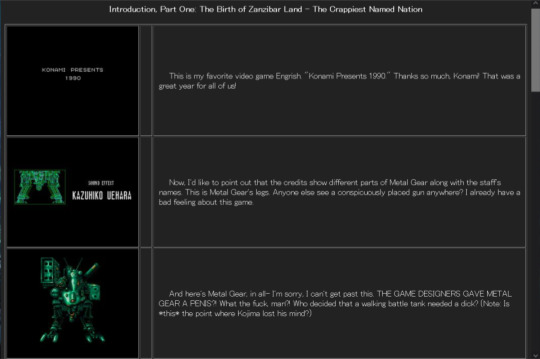
[Michael Sawyer, 2004]
In the past few years, ‘Let’s Play [Game]’ has become a relatively popular thread format on the Something Awful forums, as well as personal websites. This began with posters taking screenshots of their playthroughs of a game and adding commentary in the text. The medium has now advanced to video and is typically hosted on YouTube, with commentary overlaid. Either format gives a creator the space to play through as much of the game as they choose, and then edit exactly what content they want to show to the audience, providing commentary after the fact.
Homestuck, with its per-page illustrations, could be seen as a long thread of forum posts by the player, each including screenshots as they move through the game. The inclusion of short Flash animations shows the edge into video, and makes me wonder if we’ll see longer or more complex videos, perhaps with voiceover narration, as Homestuck expands its focus. The self-referential and aggressive yet helpful commentary in Homestuck is similar in tone to Sawyer's playthrough above, and could easily be the work of a player who knows where the story will go, at least in the short term, and is dropping hints to the audience while purposefully concealing some things.
Livestreaming video games is a similar concept to Let's Plays, but performed in real time. Often hosted on Justin.tv, an open video broadcast website that’s been gaining prominence in the past couple of years, a livestream is an improvised and unedited way to watch someone game. Any commentary from the creator happens without knowledge of how the playthrough will turn out. Homestuck, by Hussie’s own admission, is being written similarly in real life - they don’t know more than the broad strokes of how the story will go, and it’s possible that neither the author nor the narrator knows the long term implications of an action such as John stealing his dad’s PDA.
Livestreams open the possibility for viewers to influence game events, if the streamer listens to their audience. We know this is true in Homestuck - readers are able to submit commands, and some are chosen for the story. The real time nature of Homestuck, waiting each day for the new update, is equivalent to waiting for a streamer to come online and start playing again so we can find out where their game goes next. This is compounded by us having no access to Homestuck outside of the streamer - we cannot buy and play this game for ourselves, it’s still in some kind of early or limited access, and the streamer controls all our knowledge.
The livestream is definitely most similar to how Homestuck is made by its author, but it's hard to say whether its narrator is commentating in real time, or after the fact. I can't find any definite clues in our pages so far - I think the narrator wants to seem smart and superior, but I can't say whether they have the knowledge to back it up.
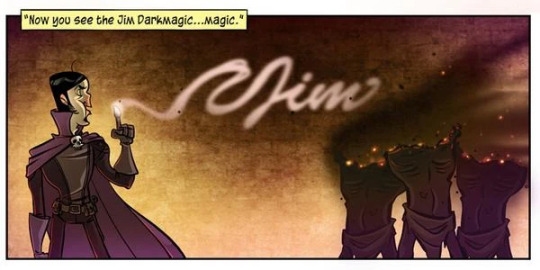
[img source]
Our final media format is known as Actual Play. Almost a year ago, the creators of Penny Arcade (along with Dungeons & Dragons game designer Chris Perkins) began releasing Acquisitions Incorporated, a short-run, officially licensed podcast where the group plays through a D&D adventure to demonstrate gameplay interspersed with jokes. This isn’t the first time a TTRPG publisher has recorded sessions to help people learn the game, but this idea seems to be crossing over into the entertainment genre - and webcomics are part of that movement.
In the first episode, the group have a brief aside. The DM says that ‘some players prefer to refer to their characters in the third person… others prefer to get into the first,’ and one player says they’ve observed the same thing in World of Warcraft. What’s not explicitly said is that the Game Master typically refers to the player characters in second person, describing what happens to ‘you’ and what ‘you’ see - much like streamers talking to their chat. The blocks of narrative text below pictures in Homestuck could easily be a Game Master balancing giving information to an unruly player, and providing entertainment for the audience. John’s lucky or unlucky moments with his sylladex could be the result of particularly good or bad dice rolls from his unseen player.
Actual play is a really great format for deep diving into a small cast of characters, and exploring their emotional state in ways that aren't intrinsic to a lot of video games. As we're already seeing the beginnings of John's emotional arc, we know this will be a focus, but we need two to four more characters with equally large roles in the story to really form a TTRPG party. Actual play also tends to include a lot of combat and its mechanics. We know Homestuck can handle crunchy mechanics due to the sylladex, but I'd expect to see the Strife concept become just as in depth and central to the story if Homestuck ends up fitting into this mold.
All three of these formats can have a mass audience, just like Homestuck does in reality - but Homestuck also feels like a very personal experience. Two people playing the same video game, even a highly linear game such as Portal or one that doesn’t involve much active interaction such as a visual novel, have slightly different gameplay based on the speed they move through the story and their missteps on the way to finding the solution to a puzzle.
Similarly, my experience of Homestuck is different from yours. I read the new update every day, while I know some people wait for a few days of updates to build up and then read a larger chunk. Maybe I clicked ‘Aggrieve’ and ‘Abjure’ three times each on p.90, alternating the options, while you clicked ‘Aggrieve’ five times in sequence and then ‘Abjure’ only twice. Maybe I didn’t realize p.110 had an interactive element at first, and skipped over it until somebody pointed it out to me (really telling on myself here). These elements of Homestuck that we have direct control over are currently only a small part of the story, but they do exist.
In this way, Homestuck feels a little bit like sitting in the living room as a kid watching your older brother play a game, begging him to let you take over for a minute, occasionally doing so until he gets frustrated with your inability to Strife and takes the controller back. The nostalgia of the simplistic graphics and the 70s and 80s games that are being evoked only adds to this cozy feeling. If Homestuck starts to add more interactive elements, such as branching paths, opportunities for us to take over the cursor, or a chance for us to use John’s sylladex ourselves and choose what he picks up, it might be worth thinking of Homestuck as different iterations of the same game, each of us watching our own, slightly different player, and even co-playing with them.
So, who IS this narrator? In my mind, I’m trying to draw a clear distinction between the author and the narrator. Hussie is the author in the real world, and the narrator, or player, or GM, exists within the work. Their role is best described on page 82:
‘The game presently eluding you is only the latest sleight of hand in the repertoire of an unseen riddler, one to engender a sense not of mirth, but of lack. His coarse schemes are those less of a prankster than a common pickpocket. His riddle is Absence itself.’
The narrator is this unseen riddler (or perhaps unseenRiddler?), providing a secondary layer of control over what happens and what we are able to see. They’re the person clicking and dragging objects around John’s room, and choosing what actions to take next. The narration is their perspective on the game - whether we see this as a GM describing a scene to their players, or a streamer reading aloud information that the game has given them and providing their own commentary.
So, we're watching the narrator play Homestuck, in whatever form it takes - but there's another layer to this. On page 22, an equivalence is made between the Sburb Beta, which John was supposed to receive on April 10 (and finally acquired on April 13 in-story, p.100), and the Homestuck Beta, which launched to us on April 10, but was quickly canceled and replaced with Homestuck proper on April 13. The Homestuck beta is linked within the comic, and might be canon within it - the narrator making an initial run at the game before restarting their save (perhaps on a different computer or console?) and trying again. Homestuck the game is currently about a kid who lives in the suburbs - and if the name and logo are anything to go by, Sburb could also be a suburbs-themed game. While we watch the riddler play Homestuck, the riddler will be watching John play the game Sburb. How deep does this go? Are there more layers inwards or outwards?

I’ve been puzzling this over for days, and I’m definitely left with more questions than I can answer. Here are the ones I'm focused on:
Is the unseen riddler playing the game as intended? Now that they’ve passed the tutorial, are they keeping the game on the rails and trying their best to follow a linear story, or are they pushing the boundaries, going for some kind of pacifist or resource-stripped run, trying to interfere with John’s intended story? Have they played the game before, and if so, how does this affect their gameplay?
If the unseen riddler is a character within the story, distinct from the external author, are we the true audience? Will there be an audience within the story, or perhaps other players? If so, how big will it be? What kind of reach does Homestuck the game have, and how many people are playing it or tuning in to watch?
How permeable are the boundaries? Is John simply pixels on a screen for the unseen riddler to play with, with no agency of his own outside of the riddler’s interpretation, like if we were playing The Sims? Or is it possible for the riddler to enter the game, or for John to leave it, and the two of them to communicate directly? Or a middle ground - something like ‘character bleed’ in TTRPGs, where a player embodies a character for so long that despite their not being real, they come to influence each other even outside of gameplay?
What the hell is the Midnight Crew? Is this a different game that exists separately to Homestuck? Will our riddler, or a different one, eventually play it? If we have three games - Homestuck, Midnight Crew, and Sburb - what exactly is the relationship between them, and how interrelated are they?
This is a lot of thoughts for what is, at time of writing, is 125 pages of comedy webcomic. But the story is just beginning, and we’ve been told it’s going to be a long day. Anything could be important, and with the frequent in-text nods to the meta elements - ‘examine third and fourth walls of room’ (p.61), ‘you decide it’s time for less meta, and more beta’ (p.113), the title appearing in the clouds on p.82 that John may or may not be able to see, the integration of the physical captchalogue card into the sylladex interface on p.98 - I don’t want to draw any firm boundaries, or make any assumptions about what is and what isn’t part of the story. Instead, I’ve cataloged the meta elements of Homestuck that might be worth paying attention to as we move through the comic, to develop a more concrete theory in time.
#running up against 'need to take classes in academic writing / get a professor to grade my homestuck papers'#also running up against the idea of 'can i cite things from later than 2009' it's helpful but does go against the spirit of the bit kinda#homestuck#analysis#im open to thoughts and feedback always#chrono
46 notes
·
View notes
Text

When the piano begins, it feels like the kind of sound you might hear in an empty room, a single note echoing against walls that hold memories of arguments, reconciliations, a life lived and left. “Welcome to the Black Parade” isn’t so much a song as it is a statement, a reckoning. It asks the listener to sit with grief, with legacy, with what it means to keep going when everything insists you shouldn’t. It is the kind of song that feels inevitable, as though it existed long before it was written down.
It begins with the memory of a father, a day in the city, and the weight of a question that is less about heroism and more about survival. “Son, would you be the savior of the broken, the beaten, and the damned?” It is not really a question; it is a sentence, a call to action delivered in the language of the dying. The kind of message that settles into your bones, not immediately, but slowly, like an ache that grows sharper over time.
The march begins. A parade, black not because of its gloom but because of its clarity. Black absorbs everything—light, memory, noise—and in the procession, there is a kind of unity. A band of misfits, wounded and weary, moving not because they know where they are going but because stopping is no longer an option. The drums hit like a pulse. The guitars roar like defiance. You do not listen to this song; you are conscripted into it.
When Gerard Way sings, “We’ll carry on,” it is not merely triumphant. It is a demand, almost a threat. A promise made not to someone else but to yourself. Carry on because what else is there to do? Carry on because the world does not wait for you to catch your breath. The refrain is both a comfort and a curse, a truth that is undeniable even when you wish it were not true.
The Black Parade itself is not death but the memory of it. It is what happens after the fact, the way loss lingers long after the moment of impact. A parade suggests movement, progression, but also spectatorship—a reminder that even in your most intimate grief, you are seen, judged, measured. The song understands this. It does not apologize for it.
What makes the song remarkable is its theatricality, the way it swells and crescendos like a life flashing before your eyes. The bridge is chaos, the kind you find in hospital waiting rooms, in airport terminals, in the seconds before the phone call that changes everything. It is too much and exactly enough. It does not shy away from its own spectacle.
Robb Stark’s story is not one of triumph. It is, instead, the slow unraveling of a boy asked to play a man, of honor colliding with pragmatism, of a family whose banners ripple in the cold wind long after their strongest voices are silenced. In the North, they call him the Young Wolf, a name that evokes power, instinct, and inevitability. But wolves, as Robb learns, do not survive long when the hunters come prepared.
Robb steps into his father’s role not out of ambition but necessity. His father is dead, his family scattered, his home endangered. There is no ceremony to it—no moment where the burden feels earned or just. He is simply required to act. To call his banners. To lead men who look to him not as a boy fumbling in the dark but as their king. The title comes not as a gift but as a demand. The King in the North. The boy in the war.
His victories come early and swift, the kind of successes that look inevitable only in hindsight. He crosses rivers, outmaneuvers seasoned generals, wins battles that no one thought he could. But battles are not wars, and wars are not won on the battlefield alone. The game that Robb plays—if he ever truly plays it at all—is one of knives hidden under tables, alliances sealed in ink and blood, and betrayals whispered before they are screamed. Robb doesn’t understand this, not really. He is his father’s son, too much his father’s son.
It is not that Robb lacks intelligence or courage; it is that these qualities alone do not save you in a world built on treachery. When he executes Rickard Karstark for treason, the act feels righteous. A king must be just, must show his people that loyalty is more than a word spoken in council. But the North, with its vast distances and old gods, doesn’t run on justice. It runs on alliances, on families bound together by necessity. Karstark’s death is not the end of a rebellion; it is the beginning of Robb’s isolation.
And then there is the girl. Her name is Jeyne Westerling, though the name hardly matters. She is not Frey, and that is the problem. The marriage is a mistake so obvious it feels almost inevitable. It is not love—it is guilt, or honor, or the confusion that arises when grief and desire meet on uneven ground. Walder Frey does not forgive such slights. Robb knows this, perhaps, but he does not understand the depth of the insult. He thinks apologies and victories will be enough. He is wrong.
The Red Wedding is not a wedding at all. It is an execution staged as a celebration, a betrayal so absolute it almost feels absurd. Robb does not die as a king. He dies as a boy, betrayed by men who once called him their lord. His mother dies beside him, her grief so sharp it becomes its own character in the room. The Young Wolf is dead, and the North breaks apart like a frozen lake in spring.
Robb Stark’s story is not his alone. It is the story of the Starks themselves, of honor that functions like a noose, tightening with every step. It is the story of a boy who believed that victory would mean survival, that loyalty would mean safety. It is the story of a world that punishes belief and devours the young. In the end, Robb is not undone by swords or armies but by a miscalculation, by the belief that justice and strategy could coexist.
And yet, his name lingers. Not as a warning, not as a lesson, but as a ghost. In Winterfell, where the snows fall heavy and the wolves howl at night, his shadow remains. For all his flaws, Robb Stark was a king, and in the North, that still matters. At least for a little while longer.
Every story in A Song of Ice and Fire circles back to fate and prophecy, as if the characters were never more than figures in a tapestry already woven. Robb Stark’s fate was not his own, not really. He was born to mirror his father, to walk the same path of honor and steadfastness, to reach the same inevitable end. Ned Stark was, after all, one of the most respected men in the Seven Kingdoms—a name spoken in equal parts reverence and regret. And when Robb took up his mantle, he inherited not just his father’s values but his flaws, the same blind spots that made him vulnerable in a world built on treachery.
Robb was formidable, a warrior and a leader in ways that Ned might never have been. He inspired loyalty, even devotion, in the men of the North. But loyalty is fragile when measured against ambition, against hunger, against the quiet whispers of betrayal. Like his father, Robb believed too deeply in a code that no longer existed, if it ever did. Honor, justice, fairness—these things made him beloved, but they also made him easy to predict. And in a game where power is won not by swords but by schemes, predictability is as fatal as a knife to the heart.
That both men were brought low by their naivety was a message, clear and brutal, to the rest of their family: you will not be allowed to live in this world. You will not be given the chance to merely exist. You will have to fight, claw, outthink and outmaneuver at every turn. You will have to shed pieces of yourself, sometimes the parts you value most. Even then, survival is not promised.
It was a hard lesson, delivered with blood and grief, but it was a lesson all the same. By the end, it was a lesson that carried the remaining Starks forward—Jon, Arya, Bran, Sansa—all of them shaped by the knowledge that the game is rigged, that no one will come to save you, that honor alone is not enough. Robb and Ned could not teach them this in life, but in death, they became the lesson.
And maybe, just maybe, that is enough. Enough for Ned, who always believed in the strength of his children. Enough for Robb, who led with a conviction that inspired even in failure. Their shadows linger long after the Red Keep falls, long after the snow melts in Winterfell. If the surviving Starks endured, it was because of the memory of their father and brother—not as men to emulate, but as warnings, as ghosts, as reminders of what it costs to believe in a world that does not believe in you.
“Welcome to the Black Parade” speaks to the story of Robb and Ned Stark, because it is the story that belongs to every father and son, and everyone in between. It's about one's legacy, and the way it's honored. It's is about the weight we carry, the way we make meaning out of loss, the way we force ourselves forward even when it feels impossible. It does not tell you it will be okay; it tells you it won’t, but that you will go on anyway. And somehow, that is enough.
#game of thrones#robb stark#ned stark#Jon snow#Arya stark#sansa stark#bran stark#george r.r. martin#cersei lannister#jaime lannister#tyrion lannister#my chemical romance#welcome to the black parade#literature#books#hbo#Richard madden#kit harrington#Sophie turner#maisie williams
4 notes
·
View notes
Text
Is fandom bigger than football?
Football fandom has its highs and lows. Conversely, excessive fandom can tarnish the sport. This issue came to the fore recently at a European fixture at Villa Park.
30th November 2023, Aston Villa versus Legia Warsaw - a night of history building for the ‘Villans’. Yet the immoral behaviours of a select group of opposing fans, dimmed the light on proceedings. Pre-game planned and targeted Violence struck fear and uncertainty to the safety of those involved.
This season alone, there has been similar issues seen at the Newcastle versus PSG fixture as well as AC Milan in their home Champions League game. This pattern of behaviour is cause for concern in the running of European competitions.
In this intense environment, I’ve learnt to appreciate that acting critically as a fan is the idyllic way to express emotions. A critical fan is one who exercises their loyalty to a team or individual, it can involve ‘attempting to change your team or fellow fans for the better.’
Some fans act critically in a space of passion and unity, binding individuals together. However, not all as seen with the examples above. This raises the question – where is the change in their behaviours going to come from?
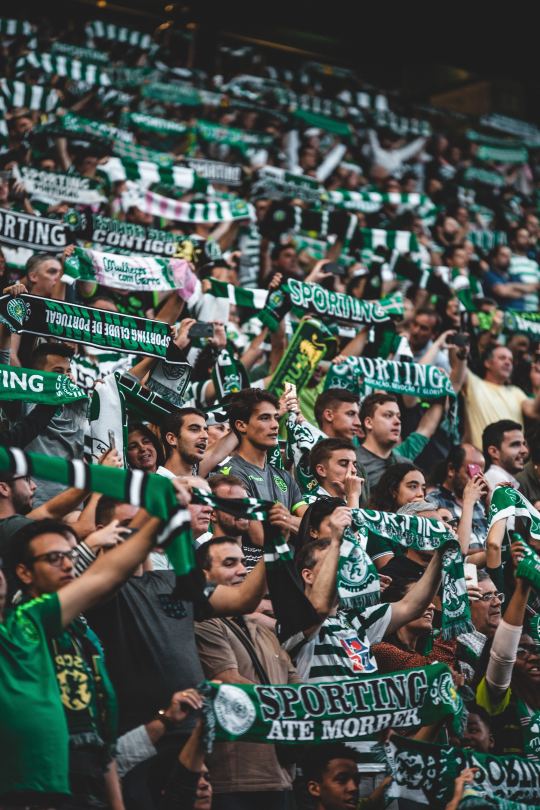
A catalyst for resulting actions
Current unruly behaviour in sports stadia is a catalyst for so many contemporary issues within football such as hooliganism, misogyny and violence. This, I believe, is why the microscope should be targeted towards addressing excessive spectatorship in the hope resulting issues can be tempered.
Integrity: a guide to follow
Individual integrity is a fundamental cog in a progressive society. Yet the actions we saw at Villa Park suggest there’s a negligence by some to act morally in a shared space. This shared space or Imagined community of horizontal unity, is a great way to depict how actions in a public setting should take into consideration of those around.
Can fandom exist without getting out of control? It is in my contention that until there’s widespread awareness of the issues outlined, there won’t be any significant change.
A deep-rooted matter
We know that examples of unrestrained fandom are not just of present times. The impact of traditions and role models has only seemed to expose and encourage younger generations to express negative behaviours. This is why I call for change and action to limit the future impact of unethical behaviour within football.
Spectatorship is intense due to its embedded interest. However, the Villa Park example fails to accept that affiliation and devotion is an acceptable reason to act un-morally.
It seems as the stage grows, as the stakes increase, the acts of loyalty by fans are in danger of taking over the sporting event itself. Without digesting into more examples, I take you back to the England Euros Final where the actions of individuals eclipsed this event. I ask, will excessive fandom always have a damning societal effect?
Sportswashing
Football is commonly characterised as being about passion, togetherness and community. These are the values that should be upheld and celebrated, rather than the unruly behaviours that shine a negative light onto the game.
Minimising and normalising unjust fans' actions turns the shoulder on fronting this current issue within football. This ‘glossing’ over of repetitive negative actions, begs the question – can there ever be a complete control of unmoral behaviours within the sport?
A fan’s perspective
Camaraderie. inclusion. Escape. Passion. These words encapsulate what it means to be a supporter. Spectatorship brings a sense of belonging, it’s a form of escapism.
However, this escapism has its dangers - the excessive loyalties manifest at Villa Park, resulted in violence and the re-emergence of the negative fan stereotypes that exist within football, such as: misogyny, aggression and abuse. How would you feel knowing your safety is uncertain when attending these matches, especially European ones?
Why now and where next?
The recent examples of excessive fandom re-iterates the notion that this is a current and ongoing issue that needs widespread attention. By increasing awareness of this issue, my hope is that we can help put the focus on what it means to be a critical fan. By doing this I believe there can be a greater emphasis on enjoying the game and appreciating those around us to bind fandom and football in a more progressive society.
Do you agree that tackling excessive fandom, could stimulate a positive response for other current issues within football such as sexism, racism, and violence?
N0981409
12 notes
·
View notes
Text
[Eroica Musical Rant] Wanna talk about media-mix?
(Series masterlist)
So, now the question I want to attempt to ask is: why? Why is this a thing? Why did somebody decide to produce, write and direct this musical even though they lack the textual understanding needed to know how?

And perhaps the answer lies in a phenomenon that’s been under fire in the recent years called: media-mix. Which, instead of consuming one piece of media contained in its medium, i.e. manga, we now live in a world where industries are creating an ecology of media with the same piece appearing in different mediums. In describing media-mix in the context of cinema, Andrew Zahlten wrote:
“[I]magine that in 1958 one entered a theater to encounter a double or triple bill that might include a comedy from the Company President series or a special-effects film such as The H Man, then returned home or continued on to food and drink. This was cinema proper, defined by a specific mode of production and, importantly, a specific space and practice of spectatorship. By the 2010s, audiences might watch the ninja character Naruto in the anime series on tv while drinking Naruto soda and browsing the Naruto website or playing the online game on their phones. In the morning they could read the manga on the train and receive tweets generated by a Naruto kyara-bot while chatting with other fans online. […] What was once cinema now entered into a less localizable space of media woven into the fabric of everyday life. […] On top of a bounded media text for consumption we find constellations of characters and worlds that are accessible via multiple, multidirectional engagements. […] Such a relation is not entirely new—just as film has always entailed connections to other media—but increasingly obvious and consequential.” [1]
The manga and anime industry has an extensive history of media-mixing their properties. From Tezuka Osamu’s Tetsuwan Atom (Astro Boy) appearing on chocolate and children's goods [2], to Kadokawa Haruki’s “dilution” of pure cinema through adaptations. Kadokawa, if you’re familiar, is one of the leading publishing houses in Japan, owning LOTS and LOTS of manga and anime properties.
And while Zahlten did not mention them, some of the most common products of media-mix are live action film adaptations and theatrical musicals. Zahlten seems to argue that the purpose of media-mix’s is to weave media into every corner of everyday life, creating more media exposures to the images of the text being promoted, letting it diffuse into the public conscious.
Hence, if someone isn’t a reader, they can always watch the anime adaptation. And if they don’t want to watch 54 episodes, then there’s always a 1.5-2-hour-long film adaptation where your favorite fictional characters are usually played by new upcoming actor or famed idol. And if you’re a fan of the stage? We got you covered too. You are sure to receive the whole experience just by sitting through this one production hahahahahahahahahaha …
On another hand, I would argue that these adaptations target the already existing community of fans in a similar way that merchandizes do. It promotes consumerism relating to a property they are familiar with, and perhaps may feel obligated to participate in this aspect of fan culture. A great example of an intellectual property being heavily media-mixed into many aspects of everyday life, if you recall in my short video a while ago, is The Rose of Versailles, created by Ikeda Riyoko – Aoike’s contemporary.
youtube
It is likely that during the past year as Aoike Yasuko celebrates her 60th anniversary as a mangaka – an amazing feat – her team might have decided to use the opportunity to boost exposure to her works. And I stand by that, more Aoike Yasuko exhibitions, books, prints, merch, GIMME ALL OF IT. But in this age of media-mix, and an adaptation of some sort is sure to garner some kind of attention – positive AND negative – and since the anime industry is kind of difficult to barge into with a 50-year-old work right now, a musical seems to be their next choice. (I would not have mind if they gave it to Guy Ritchie and so we can have another Man From UNCLE type film, but that’s just me.)
So, after everything, what have we learned from the lukewarm adaptation of From Eroica with Love?
Is it that perhaps each medium has a specific language, and when one seeks to adapt them into another, one has to translate the tone from the original to the target medium, and not just copy down every line and call that a script? Yes.
Is it that perhaps decently good actors does not necessarily a good production make? Yes.
Or is it that perhaps certain properties don’t need to be media-mixed … at all?
References
[1] Andrew Zahlten, “Introduction,” in The End of Japanese Cinema: Industrial Genres, National Times, and Media Ecologies (USA: Duke University Press, 2017), 1–2.
[2] Marc Steinberg, “Candies, Premiums, and Character Merchandising: The Meiji–Atomu Marketing Campaign,” in Anime’s Media Mix: Franchising Toys and Characters in Japan (Minneapolis: University of Minnesota Press, 2012), 40, 45, 59–63.
#not beating the elitist allegations#but it has to be done#give me more aoike exhibition#her essay books#GIVE ME MERCH#from eroica with love#eroica musical#eroica yori ai wo komete#aoike yasuko#エロイカより愛をこめて#青池保子#dorian red gloria#klaus heinz von dem eberbach#shoujo manga#70s shoujo#vintage shoujo#Youtube
5 notes
·
View notes
Text
But sportswashing serves deeper ideological functions as well. While wedging open the new zones of capital accumulation, the production of sportswashed space relies on previous established regimes of fandom that exist outside the sovereign territory of the purveyor of sportswashing. This taps into what Kalman-Lamb emphasizes as the affective elements of sport as a key site for social reproduction. He argues that capitalism creates “affective need” that is satiated through sport spectatorship. So, “fandom is a response to the affective deprivation of capitalism. It is an attempt to find meaning and community in a society that denies them. Fans watch sporting events and feel a part of something that is larger than themselves. They feel like they are part of a team and part of a community of others who are also part of that team.” Sportswashers operating on foreign turf exploit these complex relations for their own purposes, enrolling spectators, as well as athletic laborers, as political chess pieces in the process. At the same time, sportswashers risk igniting political opposition, given that fandom is saturated with affective capital, and thus gamble fomenting militant activism anchored in local concerns but linked to wider movements for justice. In this way, sportswashing both hardens and expands what Hall called the “boundaries and limits of tolerable politics” while invoking but also unsettling human-rights discourses.
—— Jules Boykoff, "Toward a Theory of Sportswashing: Mega-Events, Soft Power, and Political Conflict", Sociology of Sport Journal, 2022, 39, 342-351
3 notes
·
View notes
Text
"In queer film criticism, mainstream cinema has long stood as the culprit in distasteful and harmful depictions of LGBT people. To many critical and scholarly accounts, its history is laden with ruthless Hollywood directors and executives sensationalizing or censoring sexuality and gender variance. Accordingly, Hollywood and other mainstream industries made films littered with the vilified stereotypes of the helpless pansy, the prurient lesbian vampire, the self- loathing and confused closet case, the insatiable bisexual, and the depraved transsexual. And as one might assume, their narrative outcomes were almost always bleak. That is, of course, if the film could even get away with explicitly representing queerness instead of just alluding to or encoding it, as was the case during the Hays Code years. For critics and scholars, these texts reflected an oppressive culture determined to malign queers. The result of these depictions, it has been argued, is to help construct or reinforce harmful ideas and, for queer spectators, to produce feelings of self- disgust and inadequacy. It is in this way that trauma and harm— both self- inflicted and motivating hate in others— get centralized in queer film scholarship that charts non-avant-garde histories pre–New Queer Cinema.
(...)
In its affective politics, much scholarly queer film historiography begins to look, as Sedgwick would put it, quite “paranoid.” After all, the narrators of this history meet Sedgwick’s criteria for paranoid readings: to anticipate an object’s harm; to have faith in the ideological exposure, demystification, and decryption of its harm; and to generate others’ analogous participation by way of making paranoia teachable and mimetic. I want to stress that Russo is not the only paranoid reader in this historiography, notwithstanding his resounding influence. Reading queer cinema scholarship through the years reveals that pleasure is too often taken as suspect. The default starting point is frequently homophobia, heteronormativity, and heterosexism, the scholar then positing how these problematically structure viewer desire and identification. Further, from gender studies to film studies courses, the 1995 documentary The Celluloid Closet (Rob Epstein and Jeffrey Friedman) continues to be a mainstay of queer film pedagogy. The film version, like the book, enjoins its readers to adopt a certain kind of interrogative practice that takes representation at face value. This becomes a teachable narrative with a cogent argument and streamlined thesis about queer film history. Epstein and Friedman’s documentary, Heather Love suggests, echoes Russo’s aim to chart what she provisionally calls the “trauma of queer spectatorship.” Love, however, shrewdly observes that something felicitous happens in translation from book to screen. Although it follows the overall structure of the book, the documentary version of The Celluloid Closet (1995) supplements Russo’s narration with a polyphony of voices— ranging from scholarly expertise to personal anecdote— from critics, actors, and directors who all have close relationships to the queer films cited. Love writes, “[T] he use of interviews creates the atmosphere of a group screening, in which knowing subjects speak over and against the images we see on the screen and also drain them of their pathologizing force.” Love here pinpoints how the documentary functions as a (conscious or not) reparative modifier to Russo’s severe approach, lending other viewpoints and positions to a queer spectatorial past. Such voices, I would agree, mitigate the perceived trauma of queer spectatorship by giving necessary voice to negative affects and by restoring the place of pleasure, awkward and shameful as it may be at times. Take, for example, Harvey Fierstein’s bashfully revealing his love for and identification with the stereotype of the sissy; or recall Susie Bright relishing Mrs. Danvers’s fur fetishism in Rebecca (Alfred Hitchcock, 1940). By including clips from and romantic montages of different queer films, or even films with sparse queer moments, the documentary tacitly sidesteps Russo’s line of argumentation, thereby enacting a form of reparative historicizing that subordinates— in moments— trauma to pleasure. It brings to bear the alternate histories, where structures of multiple feelings are brought to the fore."
Marc Francis, For Shame!: On the History of Programming Queer Bad Objects
20 notes
·
View notes
Text
TW: abuse/ sexual assault
Ok im chronically on TikTok and very invested in the Brooke/ Clinton Kane thing for more than just spectatorship reasons. First of all all of the people who have moved from “Brooke’s side” to “Clinton’s side” after he posted his 20 something part story I am so envious of because they have never been in an abusive relationship. When I was 16 I was in an abusive relationship and EVERYTHING that happened echos exactly what it was like for me, it is textbook abuse. Ugh there’s so much I want to say this is going to be disorganized.
I think that part of the reason that people don’t come forward with abuse is because they are ashamed of the way they acted in response to their abuse. Crazy behavior begets crazy behavior, and when someone is psychologically abusing and torturing you and you just take it, you’re not in the best headspace and you often say and do things that are not the nicest, kindest, most responsible ways to act or respond. And it’s embarrassing. Especially if you’re not a narcissist and have a soul and empathy like most survivors of abuse do (and most abusers lack). Abusers prey on low self esteem and they cause you to act in ways that lower your self esteem. I’ve said cruel things, done cruel things. I’m not proud of it. But as I’ve gotten older and dealt with the trauma of that relationship and the impact it still has on me today, I’ve realized that it is nearly impossible to respond to insanity with clarity. I’m not a saint, above it all. I’m a human being who was being abused. I responded in kind. That doesn’t mean that it was just “toxic all around” or that I was “equally as abusive.” I think people say things like that when victims/survivors of abuse don’t respond to it “perfectly.” But all that does is shift some of the blame from the victim to the survivor.
The second thing is like a lot of people don’t talk about abuse because it can be REALLY hard to realize that abuse is happening. It is small things, even individual phrases, that compound and create something sinister. And it can take years to process and unpack it all. I didn’t realize I was sexually assaulted until 3 years after, when I woke up and randomly just remembered it. I know The Body Keeps the Score is such a cliche book but it literally does. Your body makes you forget things. Part of the reason I don’t talk more about the abuse I endured is because I have forgotten, remembered, and reforgotten it. Trauma fucks with your memory. Brooke doesn’t remembered that he got stopped by the cops going to vs from Joshua Tree. And all of a sudden not remembering that detail throws suspicion on her claim. That’s fucking trauma. Manipulators are especially good at pointing those inconsistencies out, shifting the blame off of them, and furthering your OWN feeling of insecurity and feelings of “craziness” that your abuser planted in your head.
I didn’t watch his million part thing because it was so triggering for me. It reminded me SO much of what I experienced 7 years ago, with similar wording. It is really truly amazing how many women go through TEXTBOOK emotional abuse. This is something I only learned during this seven year journey of healing. This was something that was pointed out online but it is really so true- some many women experience this abuse and so many people start to “change sides” because they just don’t realize how common this truly is. And they don’t realize how common this truly is because women are shamed and discouraged from sharing their stories. They are called gossips, dramatic, obsessed, and “yappers.” Men discourage women from forming these networks by pitting us against each other with these words and the connotations behind them.
I’m really only scratching the surface on these thoughts, but obviously my commentary on this has no real practical value.
I hope Brooke is able to find some peace, and that Clinton rots in hell for abusing these women and sending his mother to an early grave.
#tiktok#brooke schofield#clinton kane#the body keeps the score#abusiveboyfriend#abusiveness#narcissistic personality disorder#actual narcissist#my story#emotional abuse#abuse survivor#bessel van der kolk#trauma#trauma compounds#sa#women
2 notes
·
View notes
Note
‘I’m not sexually attracted to either of these men, i definitely don’t want to be in any sort of sexual situation with them, why do i find this so hot?? but i’ve since realized it’s that its the emotional intimacy that i can relate to and enjoy from the character’s whereas the physical intimacy is something completely divorced from my reality’
I relate somewhat to the other side of this coin as a straight female byler. I watched portrait of a lady on fire this year and found it very very hot. This opens a fascinating question about voyeurism and how it’s stigmatised. Humans are natural spectators, who learn by looking and watching. Sight is a dominant sense. And like you said, it was the intimacy that was hot. I think that in general, watching sex that the characters/people are into is a turn on, no matter the orientation. It’s an empathy thing - like seeing someone yawn makes you yawn, or seeing someone enjoying themselves and smiling makes you happy. (This is also why I find the darker side of the fandom (particularly people who seem to hate will and shit on Noah) to be genuinely scary, because they lack this empathy, and do actually seem psychopathic in some ways. I mean, we’re all here for this tv show, but we must all statistically be so different. theres no way to know what kind of person you’re interacting with. It’s all very odd. Thats why finding spaces that feel safe and sane (in the way that matters teehehehe) are so important for me, like here <3).
Empathy through spectatorship rather than just relatability is also why we need more queer love stories that appeal to the human heart rather than just the queer experience. The love beneath everything is what unites us all. I LOVE the way the activist / screenwriter dustin lance black, as a gay man, speaks on this. He says you have to change hearts before you can change minds. This is what storytelling and art is for, and I think s5 is going to emotionally move a lot of people who never thought they would care about a gay love story.
I also found what you said about not needing to compare your own sexual performance interesting. This is what makes gay romance or porn appealing for many straight women too: not only more maleness to admire physically, but that removal of comparison. Even though I have sex with men, I would not compare gay sex with what could be possible for me, because the dynamics are just so different. But mainly it’s the emotion tbh, especially with mike and will. I think seeing men be tender together is unbelievably beautiful; I’m a romantic at heart, no matter the gender pairing, and if a story hits - and byler does - then thats all I need.
I can remember the exact moment I realised mike might like will back during s4, after which I went back and rewatched s3, and the ending hit me like a ton of bricks. I was gobsmacked at the engineering of it all, I almost couldnt believe it. It was too good to be true - but not because its a queer pairing (as a straight woman, I imagine the potential failure of this ship won’t affect me as much as it will queer viewers who have been baited in the past) but because the whole show is so so cleverly written if byler does come to be, in more ways than just the gay romance. i dont just love byler, i admire and respect the way they've been written.
Excellent stuff here overall!
This opens a fascinating question about voyeurism and how it’s stigmatised. Humans are natural spectators, who learn by looking and watching. Sight is a dominant sense. And like you said, it was the intimacy that was hot. I think that in general, watching sex that the characters/people are into is a turn on, no matter the orientation. It’s an empathy thing - like seeing someone yawn makes you yawn, or seeing someone enjoying themselves and smiling makes you happy.
This! This is a big one. There's definitely been many times that the appeal of thinking about characters and their dynamics in other fandoms have been for other reasons - like why a lot of people like enemies to lovers, or when it's just a ship with some other specific dynamic, etc. What do you want to see? What engages you? For me lately? I'm totally drawn towards characters really in love, with a strong friendship base. Characters who make you care about them because they care about each other. The love alongside the erotic as converging elements in a ship explored in a fandom. The imagination is free to expand on what you see on screen. I like thinking about/reading/writing about Will and Mike's journey. Falling in love. All those years as besties. What happens when they get together. The interpretations of what their sexual dynamic would be, knowing the story as to how they got there. It enhances everything! From the standard show analysis to some long form fic to a silly little spicy side headcanon - we all felt some sort of connection to these two. It's not isolated. Empathy. Something that is honestly very lacking in a lot of other places...
3 notes
·
View notes
Text
What's the vibe? #52

News:
Within the past two weeks we've seen layoffs at Channel 4, LA Times, Pitchfork, Business Insider....job market is very rocky internationally at the moment. Not only that, more speaks about the legacy of culture writing and what it means when things like Pitchfork get folded into GQ or Channel 4 becoming digital?
Chaka Khan is curating this year's Meltdown @ Southbank Centre.






WIP: On Jacquemus show "Les Sculptures" + several sculpture shows:
Related to the ideas of the rise of craft - this encouragement to reject spectatorship and to make things. I still think we live in a perfectionist world but post pandemic, people were searching for intimacy and now, maybe people want to make intimate work?
see also: poetry, booktok, knowledge
I think in a year that is going to be very challenging - people are looking inwards towards the body and the power of the body - whether that's strength through the Olympics/Paralympics or performance at the Margiela show or just possibly the reinvigoration of unhealthy body image, a hangover from the 2000s. (Even pre-teens obsessing over having young skin at the beauty store) So things that represent the bodily form such as sculpture in this physical way will be in the limelight? (Getting to the conclusion of this soon.....)
Gender:

The stats that came out in this FT piece are quite concerning...but glad to know it's not just this and Matt Klein also goes through it slightly in his trend report....
I think it’ll be a defining topic to come over the next decade as this generation (18-35) grows up and start reaching into more mature adulthood and markers like marriage and children are either reached or not reached. And also what are the new markers of being human? These must include things that don't involve money, the foundations must be feelings/emotional.

One of the most interesting things I watched on the internet (hi TikTok) was an American young woman saying something like, “Men, you have to realise you’re not competing with other men; you’re competing with me”, basically saying you’re competing with her peace, her solitude etc etc. Young women are seeking peace away from violence, earning more money than ever and trying to create aesthetic spaces that represent them and young men are maybe not as visible or some are creating more harmful, misanthropic spaces?
To me it's not about how to be able to sell to people. You can think about that later. It's about societal stability, it's about the day to day lives of people and how if one gender feels out of step with the other, there will be these extreme reactions.....
The shows people have been talking about for the past few days...
JPG Couture X Simone Rocha
Make up by Thomas de Kluyver, nails by Ama Quashie, hair by Holli Smith

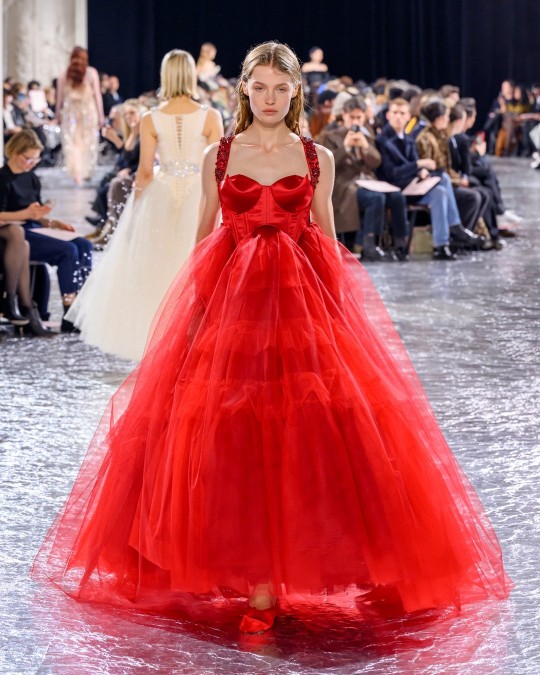
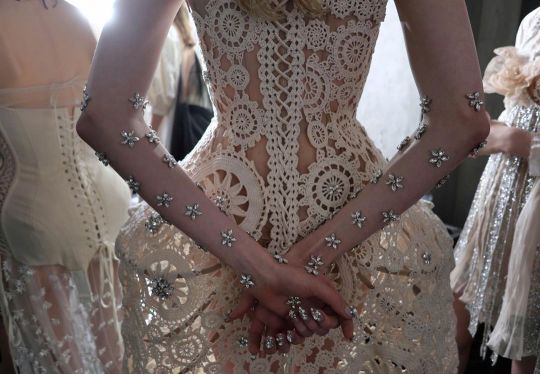



youtube
*****The STAR SHOW***** Maison Margiela Artisanal FW24 show -
What people loved: the performance, the movement of the models by Pat Boguslawski, the make up (which went viral and was by Pat McGrath) - teasing a collaboration with Christian Louboutin.
"The ritual of dressing is a composition of the self. With the body as our canvas, we build an exterior expressive of the interior: a form of emotion. The Maison Margiela 2024 Artisanal Collection paints a picture of the practices and occurrences that shape the character reflected within our dress. Under Pont Alexandre III, bathed in the light of the first full moon of the year, Creative Director John Galliano captures a moment in time: a walk through the underbelly of Paris, offline."

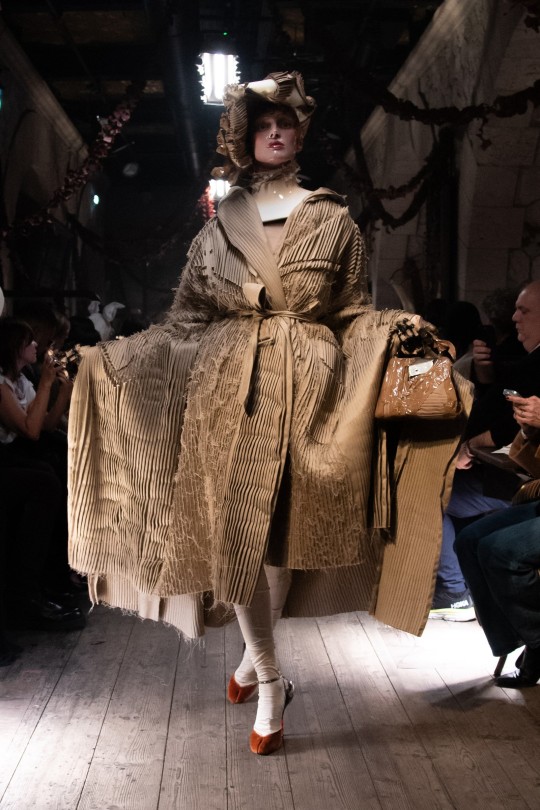
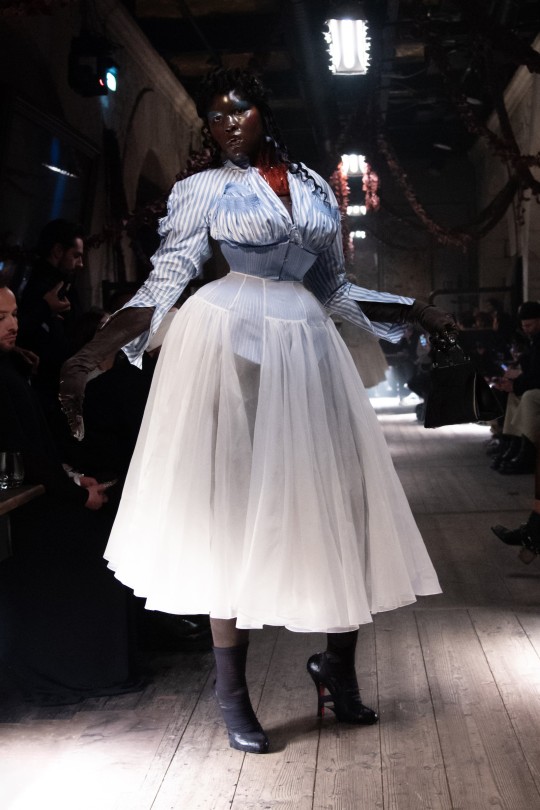
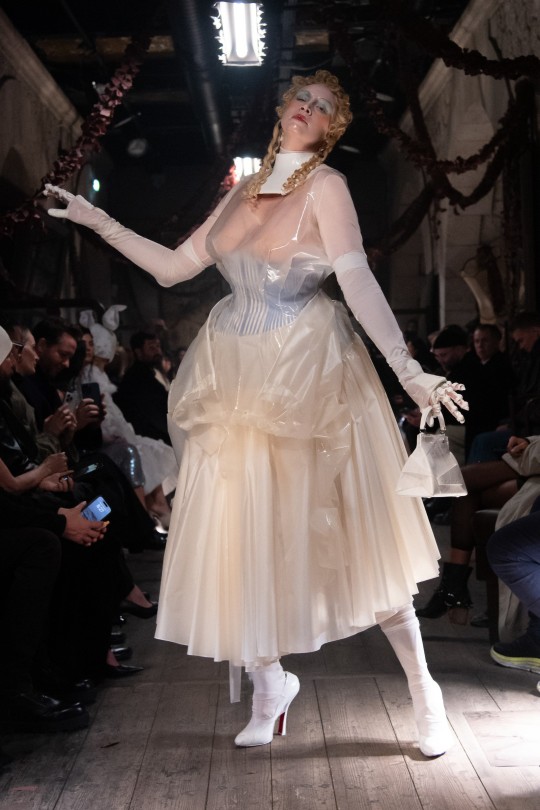
youtube
New Exhibitions:
Cute @ Somerset House
When Forms Come Alive @ Hayward Gallery
Last weeks of Rebel! @ Design Museum
Abbatoir - Aria Dean @ ICA
Reading List:
She finally made profit (good for her):
She’s also celebrating another milestone: brand profitability. After 14 years of business, Victoria Beckham finally clambered out of the red. VBHL revenues rose 44 per cent to £58.8mn in 2022, versus £40.9mn in 2021, and operating losses declined significantly year-on-year from £3.9mn to £0.9mn. This followed an injection by shareholders, including the Beckhams themselves and NEO Investments, of £6.9mn, steadying the business after a few unstable years. “The directors are pleased with the 111 per cent improvement in adjusted EBITDA for the year,” reads a company statement. “2022 marks a turning point where the group became profitable.”


An article about the changing landscape of the City of London incl plans for pedestrianisation.
2 notes
·
View notes
Text

Super Bowl LVIII | Las Vegas, NV | February 11, 2024
Wear by EA 'Bomber Jacket' - $140.00
Leading up to the Super Bowl, many TSSers have asked for a predictions post of what I thought she might wear. Truthfully? I didn’t think one was necessary. Not because the occasion isn’t a huge and momentous one - but because Taylor’s Super Bowl style has followed such a reliable formula that a predictions post felt like oversetting expectations. We love a ‘work’ uniform created in mind for a setting. And in Taylor’s ‘rookie season’ of sportsball spectatorship, she’s developed a great one.
With that, my predictions heading into this day was something black, red, with a touch of gold and a ton of sentimental value to it. Which is what we see on display here.
The combination of a black base + WEAR by EA jacket + black bustier top to me immediately harkened back to her third game - Broncos vs Chiefs on October 12 (check stories for a micro Fashion History with TSS lesson). But within this outfit itself, there are other great throwbacks to other moments in Taylor’s evolution as game day observer.
The bustier references the Balenciaga one worn to the aforementioned game, but that also bears similarities to the Versace one worn during the #killahardlaunch from October 14 when Taylor and Travis first appeared on the streets of NYC following Taylor’s cameo at SNL that night.
The embllishements harken back to the blue distressed shorts she wore to her second game on October 1 which were by the same brand (as were the butterfly jeans she wore in that first post-split candid back in April) and the colour to the dark wash Ksubi shorts she wore to her very first game on September 24.
Ending her season in this manner, with callbacks to both her style and relationship journey, feels intrinsically Taylor who has leveraged her style over the course of this season to center smaller designers (especially female-owned ones like #WearbyEA or ones local to KC), in Chiefs-oriented colours, formulated into casual but chic game day outfits that befit someone happy to be an enthusiastic spectator.
Worn with: Stephanie Gottlieb pendant and tennis necklace, Shay necklace and bracelet, The Last Line earring, Shahla Karimi + Shay + Retrouvai rings, Dion Lee top, Judith Leiber clutch, Area pants, and Christian Louboutin boots
220 notes
·
View notes
Text
31 Days of Horror - Day 12 - Martyrs
12/10/23
I begin most mornings at the moment by spinning the wheel to see which film I will watch - I like to know when I should start the film, for example, if I land on a three hour long movie, I won’t start it at midnight. Today when I first landed on Martyrs, I respun the wheel. After everything I had heard about this film, I felt that it wasn’t the best day to watch it, as before I had a family dinner out which I knew would leave me exhausted, therefore, something easier and lighter would be far nicer.
After landing on another film I wanted to watch, Blood Rage, which was exactly the type of movie I was hoping for, I thought about the free time I had today as a result of looking after my friend's cat, who is bound to my bedroom, and therefore, I am too. After sitting on it for a while, I decided to watch both! And I am glad I did :)
Martyrs is a French film directed by Pascal Laugier. The plot is ever changing as it unfolds, and has been hailed as one of the scariest horror movies ever. I see that perspective, although it feels like a weird and impossible thing to award a film. I believe I have also seen Sinister called the scariest movie ever during a long survey, which I bring up because of how different these films are! I’m curious whether people find Sinister scary solely for the jumpscares, which are amazing, or also the plot too? I think it is primarily the jumpscares, which mirrors Martyrs, which I think people find so scary because of how visceral and gross the gore is. It paired nicely with Blood Rage, which has super fun and bloody kills, whereas this film has very bloody and disgusting kills. I find the way a film can frame kills super interesting, based on how the effects are done, how long it lingers etc… Usually, slashers have creative deaths where you don’t linger on the action, they aren’t drawn out or too gross to imagine, but they’re fun to watch, and can still make you wince. There is not a single death in Martyrs that is fun.
I want to start by discussing the way the films acts work - they are incredibly divisive amongst the reviews I have read, and weirdly enough that is the most common criticism, as opposed to the fiendish gore that Saw is often criticised for! Anyway, the film's acts feel unpredictable as far as where the story goes, but I would argue the film never loses its tone, nor its purpose! The first act is a home invasion style film, where we follow a family that appears sweet and innocent as their house is broken into, and they are subsequently killed. For starters, this is such a fun juxtaposition to the grim cold open, showing our protagonist as a child, escaping from the abusive group we learn more about later in the movie. We go from that gritty exposition, to a timeskip which shows us a happy family, to a sudden series of murders. Watching the parents die, you begin to understand their innocence may not be whole, yet as we watch Lucie kill the families two children, the sequence is long, uncomfortable and deeply dark, yet unlike a film such as Cannibal Holocaust, which I will say I haven’t seen, this doesn’t feel like gore for gores sake. It was born in the New Extremity era of filmmaking, which was especially popular in France, and that shines through. My bottom line is that the gore doesn’t feel unnecessary here, it’s uncomfortable, but it is purposeful.
Quickly, I will mention that while many people liken this film to being a part of the New Extremity Wave of films, it lacks many key features of these films. The most glaring, is the absence of any sexual violence or messaging, the former I was relieved to find out, and only watched the film after researching if there was any. Ultimately, the film does retain some features from this wave, such as having a female lead, as well as centering around women as a whole, alongside the theme of spectatorship. Okay so after writing all this, I read an article that says the director in fact denounces the likening of the film to the wave of filmmaking, but I will leave it in as a result of the constant comparisons. He instead discussed this film being about a world that rotted a long time ago, which I think is a perfect explanation of the film.
Returning to the first act, we also are introduced to our protagonist, Anna, played by Morjana Alaoui. Both our leads (for this act) are excellent, showing a contrasting conflict as they deal with revenge, and who they want to be. Their relationship is also deeply interesting to me, given how little we see of it. As of yet, I haven’t been able to decide whether they are friends or lovers, Lucie is dismissive of their kiss early on, while a later phone call from Anna’s mother indicates that they are together. Either Way, I think they work well off of eachother, and have very interesting differing views.
My final thoughts on this act are left with the visions Lucie has, which are grotesque and excellent, some real fun imagery of the corpse that follows her around, attempting to kill her, and I didn’t find Anna’s dismissal of this lifelong plague Lucie has had to live with to be too bad, although thinking about it more kind of bugs me - like why not just believe she is seeing this?!
In the second act, we follow the two as they inhabit the house over night, and as Lucie deals with the vision returning. I really enjoy this section of the film, just watching them live while disputing what is best to do. Sure, it feels somewhat strange as to how lax they are about not leaving the house, but I don’t mind too much! The attempted clean up and realisation that the matriarch of the family is still alive is terrifying, as she sees a glimmer of hope, before Lucie snuffs out her life. Truly, it is dark, and the film offers no more signs of hope for anyone, as Lucie wrestles with her demon, until eventually, we watch her slit her own throat.
Despite how dark this film is, I never felt bad while watching it, which a film like Human Centipede did make me feel. Once again, intent is the key point for me! Martyrs is exposing you to a dark and twisted world, and while we don’t yet understand quite what the meaning of all this is, it does have one. In contrast, The Human Centipede seeks only to shock you, it is designed to make you feel uncomfortable, and nothing more, which isn’t my kind of film at all!
The third act follows the reveal of the torturous group, but not before one of the most spine curdling sequences! Inside the house, we find a basement, where a person is being kept. Their body is withered, but the more frightening aspect is that she has a metal clasp nailed into her eyes. Gross. After this, the group’s goal is revealed, their scale is vast and all the more terrifying! Having the film open up more works nicely in its favour, the horror is amplified when we understand that they are attempting to create a Martyr, a person who can see beyond death through torture. Knowing that they started over fifteen years ago, makes this even more chilling as we are left imagining how many people have been placed into this system.
For me, the three act structure works perfectly, each one offers us something new and different, yet they all flow together perfectly. I think of it similarly to 28 Days Later, where we switch locations and tones three distinct times, which aids in the character's development, and the scale of the scenario.
Before moving onto a more general overview, I want to mention the ending, which delivers on everything I had hoped it would. The montage of Anna growing stronger, repeating the words of Lucie in her head is deeply moving and powerful; the eventual conclusion to the film is hideously dark, and I love it.
Martyrs is a weird film, it’s one that isn’t created to make you happy or fulfil you - some of the time I was clueless as to what I was being told, yet it was sharing something, and I like it for that.
After watching the film I went to my family dinner, the tables surrounding us were filled to the brim with old people! All I could think about while I was there was the ending to the movie, as all the elderly people await their martyr that will never deliver her vision. I already know this one will latch onto me, in the short time since watching it, I can already feel its effects shiver down my spine.
7/10
3 notes
·
View notes
Text
Insight the Article: Groovin' to ancient Peru: A Critical Analysis of Disney's The Emperor's New Groove by Helaine Silverman
By Sofi Ojeda
(7 min reading / 1 page and a half essay)
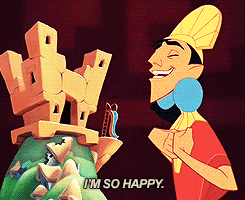
Delving into various analyses of animation often circles back to Disney, dominating the information available about animation in general. Seeking content closer to my roots as a South American woman, I stumbled upon a significant critical article. This article profoundly examines how major media platforms depict cultural heritage, influencing their audiences. Notably, it was written by a recognized archaeologist, an expert on the topic covered in one of my favorite movies: "The Emperor's New Groove (2000)," which, unsurprisingly, it had to be a Disney film.
Although I grew up just two hours away from various native cultures and near other Incan ruins in Ecuador, I don't feel capable of narrating a story from a perspective that I didn't grow up in. It's like how I relate to the challenges of women's representation in media due to the prevalent male gaze. Finding an accurate portrayal of females is difficult because this perspective often depicts women through the lens of individuals who lack firsthand experience of living as a woman. I believe this applies to cultural heritage as well, and it's a topic open for discussion. However, the article illustrates numerous examples of how this issue can affect the portrayal of cultures, particularly by highlighting inconsistencies.
Quote from the article:
"...Even committing to an official movie poster for Kingdom in the Sun (the old name of the movie*). Nevertheless, Disney apparently could not work out its relationship to the real archaeological past of Peru, since the poster shows a distinctly Mayan temple." - H. Silverman
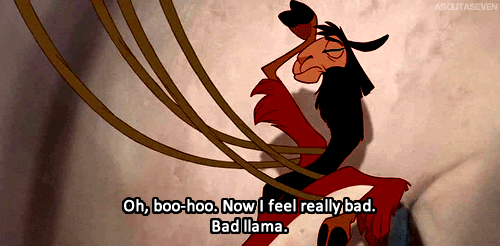
Something that surprised me about the article is how easy it was to read. Additionally, it's rich in Disney facts, encompassing the entire story of how the movie was initially planned as 'The Kingdom of the Sun,' aiming to be more historically accurate. The article contains interviews and research highlighting the lack of archaeological knowledge or desire to create a more historically meaningful film.
‘Roy Disney revealed while talking to Empire Online that Kingdom “began life as a pretentious non-spoofy kind of movie about the Inca, the Andes and all of the folklore about Sun Gods. It was really, really boring” ’- Silverman H.
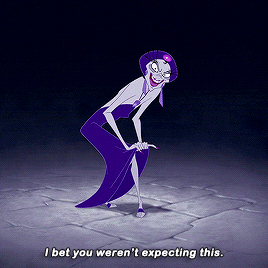
In her article, Dr. Helaine Silverman says the movie purposefully omits naming the ancient civilization, making it unidentifiable to the average American viewer. This approach mirrors a larger pattern seen in Disney films, aiming for "recognizable moments that are universal," often at the expense of fully capturing the depth and authenticity of depicted cultures.
This article's critical analysis unveils Disney's approach to cultural representation, highlighting its tendency to simplify, exoticize, objectify historical contexts and appropriate cultures without acknowledgment. The insights encourage deeper introspection into how movies like "The Emperor's New Groove" perpetuate stereotypes, urging readers to look beyond surface-level portrayals and seek a genuine understanding of cultures in entertainment. These actions raise deeper concerns related to contemporary discussions on representation, such as simulacra, postmodern spectatorship, the dissolution of cultural identity, and the implications of placelessness and travel in media narratives.

It is important to mention that Helaine Silverman is a renowned archaeologist and cultural researcher, she currently holds the title of Full Professor in the Department of Anthropology and directs CHAMP/Collaborative for Cultural Heritage Management. Possessing a Ph.D. in archaeology, her scholarly contributions have earned her acclaim in academic spheres. She explores the interplay between media, public interest in history, and Peru's incorporation of ancient civilizations in shaping its national identity. Her extensive academic career spanning close to three decades has primarily revolved around the archaeology of Peru's southern coastal region.
''They are not innocent errors. They are the result of a very particular attitude in the Disney studio that essentializes, exoticizes and objectifies the past and those who created it.''- Silverman H.
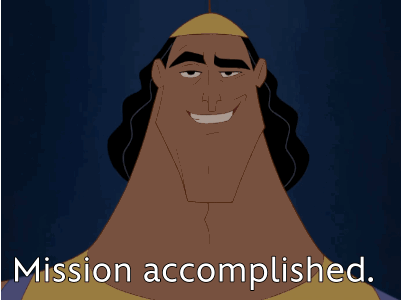
I would highly recommend this article, not just to gain insight into Inca culture, which extends beyond Peru, but also to highlight the significance of being mindful in how we depict minorities and challenge the romanticized, fictionalized versions often perpetuated by mainstream media. The excerpts underscore the importance of respecting and comprehending cultures without appropriating or mystifying them for commercial purposes, emphasizing the critical need for genuine and respectful representation in media.
Bibliography
Full article: https://citeseerx.ist.psu.edu/document?repid=rep1&type=pdf&doi=9350dc757bb6628baff9a0cec169056810b4639b
Silverman, H. (2002). Groovin’to ancient Peru: A critical analysis of Disney’s The Emperor’s New Groove. Journal of Social Archaeology, 2(3), 298-322.
Video: https://www.youtube.com/watch?v=OvGsh5H5RoE
https://publish.illinois.edu/helainesilverman/
https://journals.sagepub.com/doi/abs/10.1177/146960530200200302
#2d animation#animation#animation history#animationblog#writing#movies#walt disney#helaine silverman#the emperors new groove#movie critique#film critique#disney animation#movie analysis#film analysis
2 notes
·
View notes
Text
extrahi (Abyssal Hunters)
AK/Kinktober 2023, Day 21: “Stress Test”
Laurentina's turn!
"Shark."
"Oh, I'd be delighted, Orca! Come here, come here," she beckons to Skadi, who is all but summoned forth by the wave of Shark's hand. "I was just thinking how I've paid my dues to the Captain, and Cuttlefish clearly needs a moment before she joins back in on the fun…"
"Whatever you want, Shark."
"Well, as it happens, I did eat something disagreeable earlier."
"From the canteen?"
"They did try and tell us today just wasn't a seaweed day, true. But that's not what I mean—you see, I saw something I disagreed with, and so I ate it. And I'd rather like it out of me now."
"Mm." Given no pause at all, Skadi immediately understands what Specter is asking for.
Thus, Skadi is directly in Specter's face, then in a manner so rote the assurance of it is graceful, she accommodates her fingers inside Specter's open, waiting maw.
In front of Gladiia's supervisory and observatory patience, in front of Andreana's subdued first-timer spectatorship, indomitable red begins to be drawn where Laurentina's teeth become the marrer of lines through Skadi's skin.
The first width is the knuckles, scraped and bled apiece in order to cross the pass between outside and inside. Skadi's fingers now begin to curve their way down along Specter's gullet, towing the entire rest of the appendage behind them, travelling and disappearing into Laurentina's mouth before her very eyes.
Second come the opposite eminences of the hand, flesh below the thumb and the little finger; this too Specter gladly lets her teeth sail through, producing thas one's carmine to this one's lips—it's a beautiful thing, Skadi. A gulp sees Specter's throat open to allow down the hand that widens it. The stretch is far beyond unusual already; the protrusion is strained through her skin to all observers. That's Orca's hand in there, she would love to say to them, exactly at the time she can't. Hopefully, the twinkling delight in her eyes says it in her place.
Third comes the wrist. Both top and bottom now rake pristine, shining lines that unlock glazes of soothing velvet from Skadi's rough shell, the muzzle of Specter's face already close to painted as decadent as a feast. A hint harder, and perhaps pop would go an artery. Specter's jaw aches, expression forced into a wince. On you go, Orca.
Now is the reach of Skadi's forearm, and Specter tilts her head back to allow Skadi's entire limb to continue descending into her. Orca tastes luxurious, and feels luxurious inside Specter, who by all rights would be far overtaxed were it not for her body's sheer persistence. Flesh, lesions, tears, enduring, reforming, housing its new occupant while needs must. Specter attempts to swallow, and feels her muscles ripple around something far wider, cascading in sensation inside her, descending her body's upper core.
And then, Skadi stops. Exploratory pushes throb and transmit from within Laurentina, each to somewhere different on the belly outside. She's made it. Well done, Skadi, she lauds her, a spectacle of an arm-swallower, each shift of Skadi's limb rearranging the shaft it sheathes itself in inside Laurentina. Yes, Shark of the Second must look such a pained mess right now—isn't it wonderful?
"Found it."
And here comes withdrawal.
Specter's teeth now drag their dainty way back down Skadi's long, long length. Goodbye, stomach—oh, oh, Skadi, careful, you know you're nudging it upwards? If you don't remove your hand any more decisively, you'll pull my poor stomach straight out of my mouth…
And with an ensuing raw and meaty shift, that settles back into place, and above it each inch of Specter's strained gullet is next to bid farewell to Skadi, who tows some small artifact just as sturdy as herself at the tip of her fingers, up through Specter as she steadily empties.
Up, up, out, until…
"Ah!" Hoarse and faint, but a few coughs to encourage her throat to unclear gets her somewhere again. Excellent, one more respect in which she's still in shape!
Laurentina is a bloodied mess of a visage, feeling tunnelled open straight from her mouth down, distended jaw batted by hand back into sore place, grin now once again fully able to unfold to her audience. Let's see—the Captain is impassive, given, given, she's always a hard one to impress. Cuttlefish, however, is fun.
Yes, Andreana's sight is fixed on the spectacle—on Skadi's Shark-bitten arm, sopping with plasma and saliva and digestive slime and a modest coating of acid, and in her nonchalant clutch, a condom borrowed from Engineering in its sedate wrapper.
It takes Andreana a few tries to close her own hanging jaw shut before she can remark. "That's mine."
"I know! Now, do you still want to put this fucking thing on, Cuttlefish?"
"No."
"Good!"
#BDSMKinktober#arknights#this one has a read more because skadi is reaching far far more than finger-deep
5 notes
·
View notes